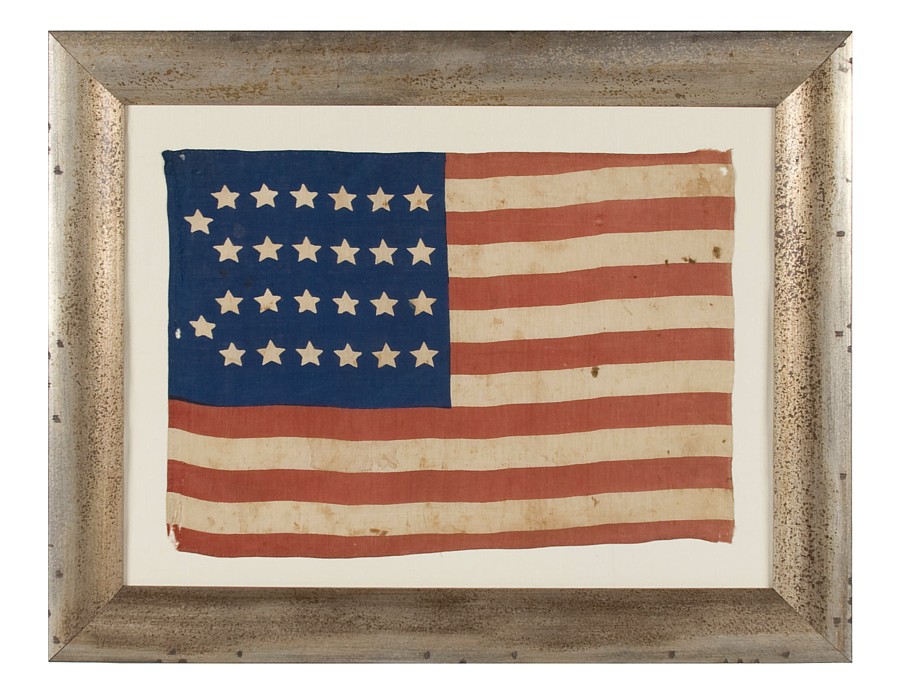
| |
26 STARS, THE EARLIEST KNOWN STAR COUNT FOR PRINTED FLAGS, 1837-1846, MICHIGAN STATEHOOD, ITS CANTON RESTING ON THE "WAR" STRIPE |
|
| Available: |
Sold |
| Frame Size (H x L): |
34" x 42.75" |
| Flag Size (H x L): |
22" x 30.5" |
|
| Description....: |
|
26 STARS, THE EARLIEST KNOWN STAR COUNT FOR PRINTED FLAGS, 1837-1846, MICHIGAN STATEHOOD, ITS CANTON RESTING ON THE "WAR" STRIPE:
Printed flags are called "parade flags" or "hand-wavers". The earliest varieties have either 26 stars, like this very rare example, or 13 stars, made during the same period, but with an eye to our colonial past as opposed to reflecting the actual star count of the period. The 26 star flag became official on July 4th, 1837, following the addition of the State of Michigan, and remained so until after the addition of the 27th state (Florida) in 1845. Only a small handful of 26 star parade flags are known to exist; maybe fewer than 20 at present. The remainder of the printed flags of this era, with 13 stars, are equally rare.
The earliest examples of this period that can be dated to a specific year were made in 1840 to promote the presidential campaign of William Henry Harrison. These include either a printed rendition of his portrait in the canton or the stripe field and/or printed text in the stripes. The earliest examples are mostly square in shape. This could reflect the square shape of infantry flags and regimental banners of the period, or it may simply be an unexplainable design choice of flag-makers. At least one maker has identified examples that are both rectangular and square, however, and by 1844, more rectangular examples emerged.
This particular 26 star American National parade flag is printed on cotton and bound at the top and bottom with hand-stitching. The stars are arranged in 4 rows of 6 stars, with 2 stars staggered before them at the hoist end. These roughly form two exaggeratedly long "C's". This very rare arrangement is seldom seen in any other star count, but seems to have been popular in flags with 26 stars.
The fact that the canton rests on a red stripe is a very rare trait. Some flag historians refer to this as the "blood stripe" or the "war stripe", suggesting the flag was sometimes constructed in this manner when the nation was at war. There is also evidence that the Navy used this design feature on at least some of its flags made during the mid-19th century. Sometimes the placement was undoubtedly by accident. In any event, the war stripe is a highly desired feature in early American flags and it is particularly rare in printed examples.
In summary, this is one of the earliest known American parade flags, with both interesting visual appeal and two very rare features, making it a terrific addition to any flag collection.
Mounting: The flag has been hand-stitched to 100% hemp fabric. The hand-gilded and distressed Italian molding has a bold, convex profile. Spacers keep the textile away from the glass, which is U.V. protective.
Condition: There is minor to moderate foxing and staining, but there are no serious condition issues. Many of my clients prefer early flags to show their age and history of use |
|
|
|
| Collector Level: |
Flags for the truest Patriots. My best offerings |
|
| Flag Type: |
Parade flag |
|
| Star Count: |
26 |
|
| Earliest Date of Origin: |
1837 |
|
| Latest Date of Origin: |
1845 |
|
| State/Affiliation: |
Michigan |
|
| War Association: |
1777-1860 Pre-Civil War |
|
| Price: |
SOLD |
|
| |
Views: 3663 |
|
|
|

